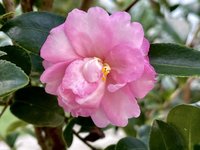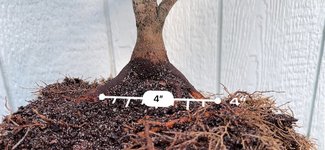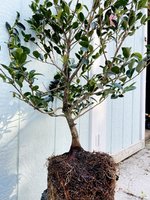Here are a couple more pictures of the best base/nerabi (about 4" at widest in the roots and about 2" at base of taper - these came in a 3 gallon pot). This one has a date of May-2018 in the tag. The question asked about why Camellias are not as often used for Bonsai is kind of a puzzle to me, but I may find out the hard way

. I may let these ones grow a couple of more seasons before repotting. The only thing that I am doing to them is removing the additional soil that was put over the roots.
Nice finds. I would keep the "Nebari" buried to the original soil line. Your actual nebari is less than 4 inches. Your nebari is only about 2 to 3 inches, the rest is "roots". If you expose that to the 4 inch wide point, you will ruin the nebari in no time. This tree is too young to expose the roots yet. Expose the roots now, and you will end up with an ugly volcano of irregular size roots with a tree perched on top. The "volcano" will require a deep pot. Keep this buried, and you will be able to work this tree into a more shallow pot, and in the future this will be a wide radial nebari. Its a nice start, but keep it buried. Look at it while repotting, do pruning to improve the flat radial arrangement, then bury those roots. Exposing the nebari is only done very late in bringing a tree to exhibition condition. Expose too early and you ruin it. You end up with trees like a certain un-named curmudgeon who started a "philosophical thread" trying to make trees with bad nebari socially acceptable. Where if the nebari had been kept buried early in their trees development they would not be complaining later.
Camellia as bonsai are moderately common in Japan. They are only rare in USA. There are several reasons why.
In Japan, larger scale, more than a meter tall or wide bonsai are more common than in USA. Camellia leaves do not reduce well, and the flowers are large, so they are most often used for medium to larger size bonsai, more than a meter tall. They can be used for smaller bonsai, but it is difficult to get proportions correct as a smaller tree. Small trees are often trained more like Ikibana or Literati, slender, graceful, elegant, with few branches and perhaps only allowed a single flower, or just a handful of flowers. Fat trunks on a Camellia take some skill & time to get on a shallow root system.
Camellia are a common outdoor landscape plant only in the southeastern USA and in the Pacific Northwest. In the southeast there are areas they can not be grown, because they require a moderately acidic soil. If your soil is limestone derived, you need to do significant amendment of the soil to get the Camellia to survive. They do not do well in areas with high heat and low humidity. They do not survive well in climates colder than 7a or 6b. So Texas and California are too hot and dry for them to be easy, Illinois and the northern tier of states are too cold. All in all if you are not in Georgia or western Oregon, you are outside the ideal regions to grow Camellia. Now plenty of people figure out the extra steps needed to grow them away from ideal regions, but they are not that easy to grow if your climate is not favorable.
Camellia "starter bonsai stock" is simply not common in the USA. In Japan, they have been cultivating trunks for eventual bonsai in bonsai orientated nurseries for at least a century. If you want a 4 inch (10 cm) diameter trunk, to start training as bonsai, in Japan it is easy to get one with a flat, radial root system. In the USA, the only 4 inch trunks have roots that go straight down and would require a 20 gallon nursery pot to keep the roots in soil. All the Camellia being produced in the USA are being produced for the landscape industry. So starting material in the USA either has to be young, with "skinny trunks" in order to get the roots into shallow pots, or you have to spend the significant time to create a new root system on a larger, older landscape stock that one would be forced to start with in USA.
Those are the main reasons that Camellia are not often seen as bonsai in the USA. The should be more common. But they are not.









